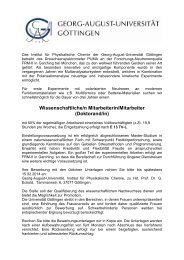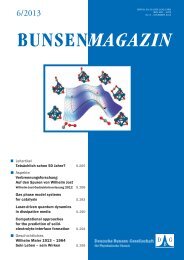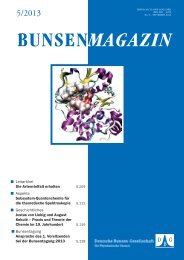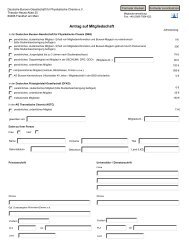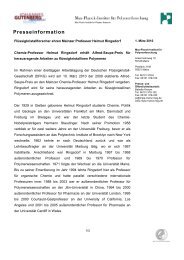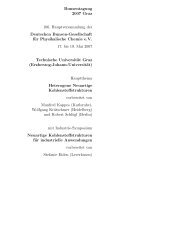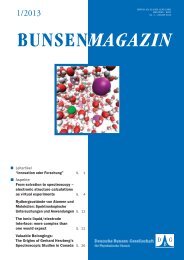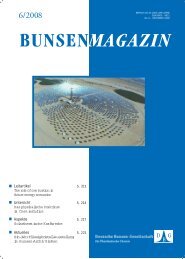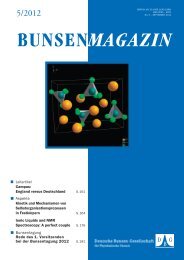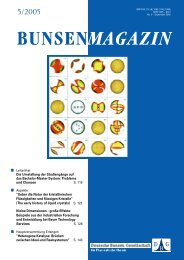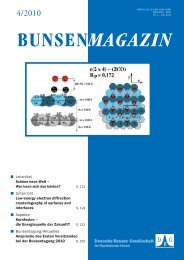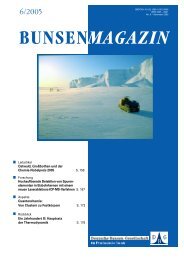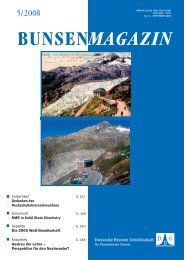BUNSENMAGAZIN - Deutsche Bunsengesellschaft für ...
BUNSENMAGAZIN - Deutsche Bunsengesellschaft für ...
BUNSENMAGAZIN - Deutsche Bunsengesellschaft für ...
Erfolgreiche ePaper selbst erstellen
Machen Sie aus Ihren PDF Publikationen ein blätterbares Flipbook mit unserer einzigartigen Google optimierten e-Paper Software.
UNTERRICHT<br />
Gunther Brunklaus and Hans-Wolfgang Spiess<br />
1. INTRODUCTION<br />
Dr. Gunther Brunklaus<br />
MPI <strong>für</strong> Polymerforschung<br />
Ackermannweg 10, D-55128 Mainz, Germany<br />
Phone: +49 6131 379 240<br />
FAX: +49 6131 379 100<br />
E-Mail: brunklaus@mpip-mainz.mpg.de<br />
62<br />
SOLID STATE NMR OF<br />
SUPRAMOLECULAR SYSTEMS<br />
In the fi eld of materials science, the precise knowledge of structure<br />
and dynamics of macromolecules and supramolecular<br />
systems in principle allows for a rational design of well-defi ned<br />
architectures with tailored properties, such as effi cient proton<br />
exchange membranes 1 (that are used in fuel cells), photonic<br />
sensors and devices 2 or gene delivery systems. 3 The physical<br />
properties of (mainly organic) polymers and supramolecular<br />
aggregates, for instance, can be substantially improved by controlling<br />
their microstructure and processing conditions. Indeed,<br />
the local arrangement of the respective building blocks within<br />
the material relative to each other and their mobility on different<br />
length- and time scales critically determine their specifi c<br />
functions. 4 In fact, in supramolecular chemistry, 5 the same key<br />
elements of organization 6 are used as in nature, namely, hydrogen<br />
bonds, p-stacking, shape control, and surface effects<br />
(cf. Fig. 1). At present, manifold complementary characterization<br />
techniques such as scattering of light, 7 X-rays 8 and neutrons<br />
9 , various forms of microscopy 10 as well as mechanical 11<br />
and dielectric 12 relaxation are available.<br />
Figure 1: Key elements of supramolecular assembly. 6<br />
In addition, Nuclear Magnetic Resonance (NMR) spectroscopy<br />
is a remarkably versatile and powerful tool that has found widespread<br />
applications in materials science. 13 Since NMR allows<br />
for element-specifi c observation of different nuclei, it provides<br />
an outstanding selectivity for local environments. 14 Moreover,<br />
Prof. Dr. Hans-Wolfgang Spiess<br />
MPI <strong>für</strong> Polymerforschung<br />
Ackermannweg 10, D-55128 Mainz, Germany<br />
Phone: +49 6131 379 120<br />
FAX: +49 6131 379 320<br />
E-Mail: spiess@mpip-mainz.mpg.de<br />
BUNSEN-MAGAZIN · 11. JAHRGANG · 2/2009<br />
dynamic features can be studied over many decades of characteristic<br />
times, ranging from picoseconds to minutes, 15 and<br />
length scales from interatomic distances in the 100 pm range<br />
up to a meter or so in NMR imaging. 16 This wealth of information<br />
accessible by modern NMR spectroscopy is based on the<br />
fact that a large variety of interactions of nuclear spins with<br />
their local surroundings can be selectively exploited. 17 For a basic<br />
description of the NMR experiment and a comprehensive<br />
introduction to the interactions that possibly govern NMR spectra,<br />
we refer to text books 15,17,18 and a previous article within<br />
this series. 19 Indeed, the rich information content of solid-state<br />
NMR spectra renders them rather diffi cult to handle, in particular<br />
if several sources of line-broadening like dipole-dipole<br />
couplings and quadrupolar interactions 20 have to be taken into<br />
account. Recent developments in NMR methodology, however,<br />
provide possibilities to selectively suppress and/or (re-)introduce<br />
nuclear spin interactions where the different sources of<br />
information can be separated and correlated using multidimensional<br />
NMR techniques (see below).<br />
Some advanced NMR techniques are introduced in Section<br />
2, while Section 3 describes selected applications of studying<br />
structure and dynamics of supramolecular structures based<br />
on the key elements presented in Fig. 1, mostly taken from our<br />
own laboratory.<br />
2. NMR METHODOLOGY<br />
In the following section, we describe selected versatile techniques<br />
available in modern high-resolution solid-state NMR<br />
spectroscopy. Most of them are based on either homo- or heteronuclear<br />
dipolar couplings and facilitate studies of self-organisation<br />
in the solid-state.<br />
2.1. ANISOTROPIC SPIN INTERACTIONS<br />
Information that can be extracted from (high-resolution) solidstate<br />
NMR spectra is encoded via spin interactions such as<br />
the chemical shift, the quadrupolar interaction, homo- and heteronuclear<br />
dipolar interactions, as well as J-couplings. In principle,<br />
the relevant spin interactions are anisotropic and can



